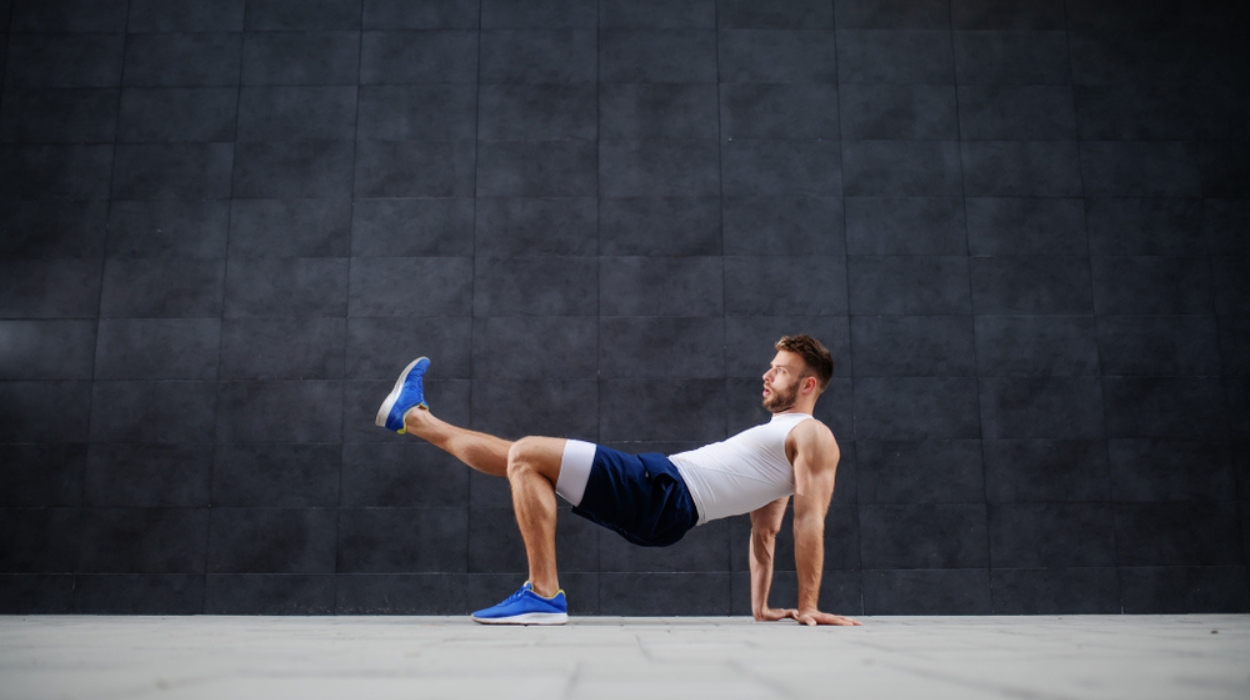
Achieving well-defined shoulders often requires having a balanced workout plan. This involves targeting the often-neglected rear deltoid muscles.
Like the commonly appreciated anterior and middle deltoids, the rear delts play an important role in developing robust shoulders. These muscles contribute to stability, improve posture, and help improve the strength required for everyday activities.
In this guide, we explore the top eight rear delt bodyweight exercises; each is specifically designed to strengthen and sculpt your shoulders without the need for additional equipment. The exercises are strategically chosen to isolate and engage the posterior deltoids. They also target the secondary muscles of the shoulder blade and rotator cuff.
Ten Best Rear Delt Calisthenic Or Bodyweight Exercises
- Ring Face Pulls.
- Ring Rear Delt Flys.
- Standing Reverse Lean.
- Parallel Bar Victorian Lean.
- Supine Wide Bodyweight Rows.
- Prone T Raises.
- Prone Y Raises.
- Reverse Plank.
- T Rotations.
- Bodyweight Back Widows.
These exercises are a convenient and versatile way to challenge your shoulder blades with just your bodyweight. Performing calisthenics helps to improve your stability, increase strength, and prevent injury.
Best Bodyweight Exercises For Rear Delts And Calisthenics (With Equipment)
If you’re looking to work out your shoulders, these bodyweight workouts are a great option for both beginners and fitness enthusiasts. They offer a comprehensive and challenging approach to rear deltoid development.
Ring Face Pulls
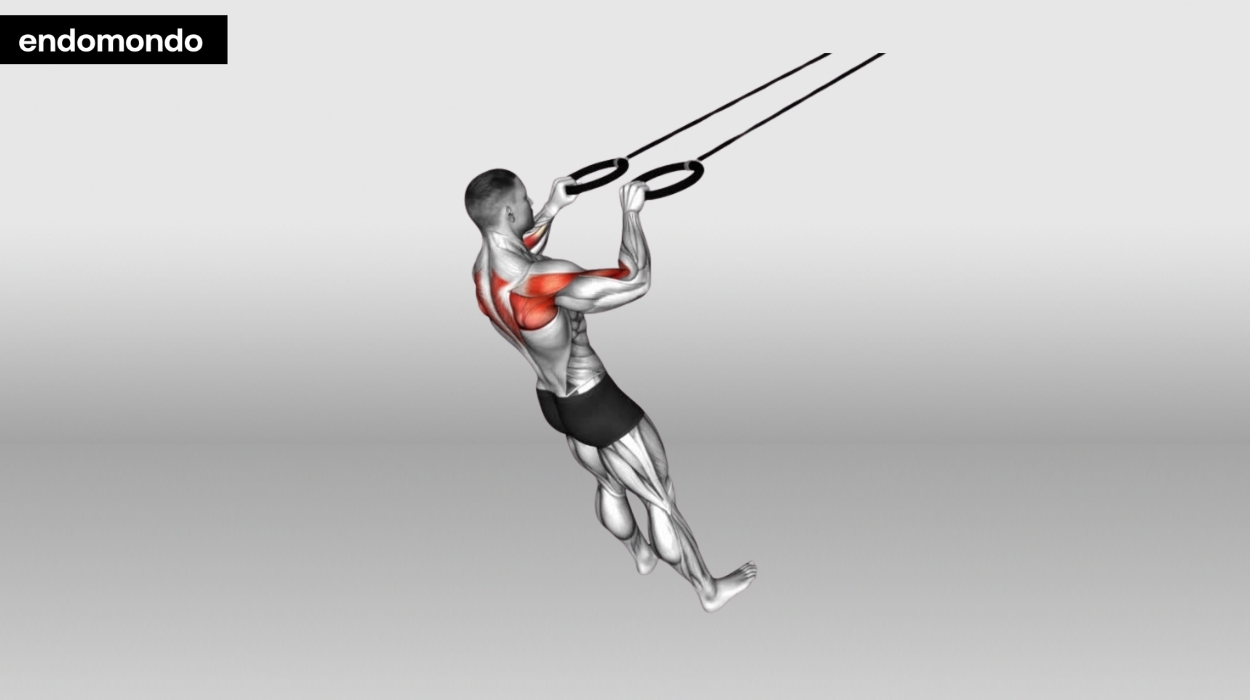
Using gymnastic rings, this exercise primarily targets the rear deltoids, upper traps, and upper back muscles. Pulling your face towards the rings at eye level effectively engages your scapular and challenges the deltoids. The adjustable nature of the rings adds instability, activating the core muscles for improved stability.
Benefits of this exercise include improved stability, postural endurance, and getting bigger shoulders.
How to do:
- Keep the rings in line and grab them tight so your wrist lines are straight.
- Get into the starting position or a 20-degree to 45-degree incline while holding the rings. Your elbows should be locked straight for stability.
- From the hanging part, squeeze your blades together as you pull yourself forward. Bend your elbows as you externally rotate your arms or move them closer to your ears.
- Keep your arms at a 90-90 degree angle and hold the position for a count.
- Slowly lower yourself back.
Tips:
- Focus on bringing your shoulders together and down as you move to better engage the posterior or back musculature.
- Be sure to exhale as you bring your shoulders together to better engage your core.
Optimal Sets And Reps: Find a comfortable rep range when first starting. Three sets of 6 to 8 reps could be an appropriate goal for many beginners. For a more advanced workout, start at a more horizontal angle to the ground.
Ring Rear Delt Flyes
The rear delt fly is an exercise designed to strengthen the rear deltoids, emphasizing the posterior aspect of the shoulder. Performing this movement involves pulling your body against gravity.
The exercise also targets the middle traps and rhomboids.
By isolating the rear delts, the exercises contribute to enhanced stability, improved posture, and muscular development. It is also beneficial for muscle imbalances, especially for individuals whose workout routines often focus on the front deltoids.
How to do:
- Adjust the rings to just above your shoulders.
- In a standing position, start with your arms locked out, hips extended, and shoulder blade retracted or squeezed together.
- Lean back and keep your upper torso straight.
- Begin by pulling your arms away from each other.
- Keep your arms straight throughout the motion.
- Hold for a count.
- Begin to lower yourself through the eccentric phase with a slow and controlled pace.
Tips:
- Avoid excessively bending your arms.
- Squeeze your blades at the top of the movement.
- The closer you are to the anchor point or rings, the easier the exercise becomes.
- Progress this activity by positioning yourself further away from the anchor point.
Optimal Sets And Reps: Evidence suggests that building lean muscle mass[1] occurs when three to four repetitions remain in the training set. Find a repetition range that feels comfortable to you and that you can perform safely. Just make sure that you perform a high enough number of repetitions that you fatigue near the end of your set.
Standing Reverse Lean
Mastering the standing reverse lean demands a higher amount of shoulder strength and stability than the previous exercises. The use of parallel bars is common in the calisthenics community and this is a great introduction to more intermediate to advanced exercises.
Begin with smaller angles and shorter duration holds before progressing to longer times. The reverse lean engages your posterior delts and maximizes muscle engagement to improve the stability of your shoulders.
Progressing this exercise can be a challenge. However, it’s a great way to strengthen your core and elevate your overall upper body strength.
How to do:
- Stand facing a stable horizontal bar or parallel bars at waist height.
- Grip the bars with both hands, palms facing inwards.
- Position your feet shoulder-width apart for a stable base.
- Gradually lean backward, extending your arms.
- Keep your body straight, forming a diagonal line from head to heels. Maintain tension in your shoulders and back muscles.
- Hold the leaned-back position for a few seconds, focusing on balance and controlled muscle engagement.
- Slowly return to an upright stance, maintaining control. Use your core and back muscles to control the descent.
- Perform the exercise for the desired number of repetitions.
Tips:
- Start with a slight lean and gradually progress to a deeper angle as strength improves.
- The key is to position your hips just slightly in front of your shoulders.
- Try to limit the amount of body momentum and focus on controlling the movement.
- Focus on maintaining a straight body line throughout the movement for optimal engagement.
Optimal Sets And Reps: Perform 2 to 3 sets of 10 repetitions. Incorporate isometric holds at different angles to improve your strength and endurance. Hold the position for a few seconds and gradually increase the duration as you gain strength over time.
Parallel Bar Victorian Lean
This is an advanced exercise that requires significant upper body and core strength. If you are new to calisthenics or have any concerns, consult with a fitness professional before attempting a Victorian Lean. Start with easier progressions, such as the aforementioned standing reverse leans, and slowly progress yourself.
How to do:
- Begin by standing or kneeling between the parallel bars at wrist height.
- Grip the bars with both hands, palms facing forward.
- Lift your legs off the ground, bringing them parallel to the floor. Keep your body straight, engaging your core.
- Gradually lean your upper body backward while maintaining the parallel position of your legs. Aim to achieve a horizontal body position.
- Find the balance point and hold the position. Focus on stabilizing your core and keep a straight line from head to toe.
- Slowly lower your legs and return to the starting position. Ensure a controlled descent to maximize muscle control.
- Perform the exercise for the desired number of repetitions or hold for a specific duration.
Tips:
- Maintain a tight body position throughout to enhance stability.
- You may need to use body momentum to help you lean back at first.
- Have a spotter assist you by holding your legs as you practice the movement.
- Gradually increase the difficulty by extending your legs further and lowering your body closer to a horizontal position.
- Practice consistently and be patient to improve strength and control over time.
Optimal Sets And Reps: Perform 2 to 3 sets of 10 repetitions.
Supine Wide Bodyweight Rows
This exercise targets the traps, lats, and rear deltoids and can be a part of your barbell shoulder workout. using gymnastic rings. It can also be performed with gymnastic rings. The wide grip emphasizes the latissimus dorsi, the largest muscle of your back, promoting a V-shaped sculpture.
Benefits of this exercise include increased strength in the upper back, improved posture, and enhanced stability. The nature of the barbell provides stability, promoting muscle engagement and contributing to comprehensive upper-body development.
How to do:
- Grip a standard barbell bar with a pronated grip (palms facing away from you). Keep the grip wide so your hands are wider than your shoulders.
- Slowly lower yourself toward the floor so that your arms are completely straight.
- Maintain a straight body position, creating a plank.
- With a pulling motion, bring your chest up towards the bar. Squeezing your blades together as you move.
- Hold for a count and slowly lower your body back down.
Tips:
- Engage your core by using your breath for added stability.
- Keep your body straight throughout.
- Adjust the difficulty by altering the bar height and angle. The more parallel to the floor you move, the harder the exercise will be.
Optimal Sets And Reps: Find a comfortable rep range when first starting. Three sets of 6 to 8 reps could be an appropriate goal for many beginners. For a more advanced workout, the contraction for a longer duration.
Best Bodyweight Exercises For Rear Delts And Calisthenics (Without Equipment)
Prone T Raises
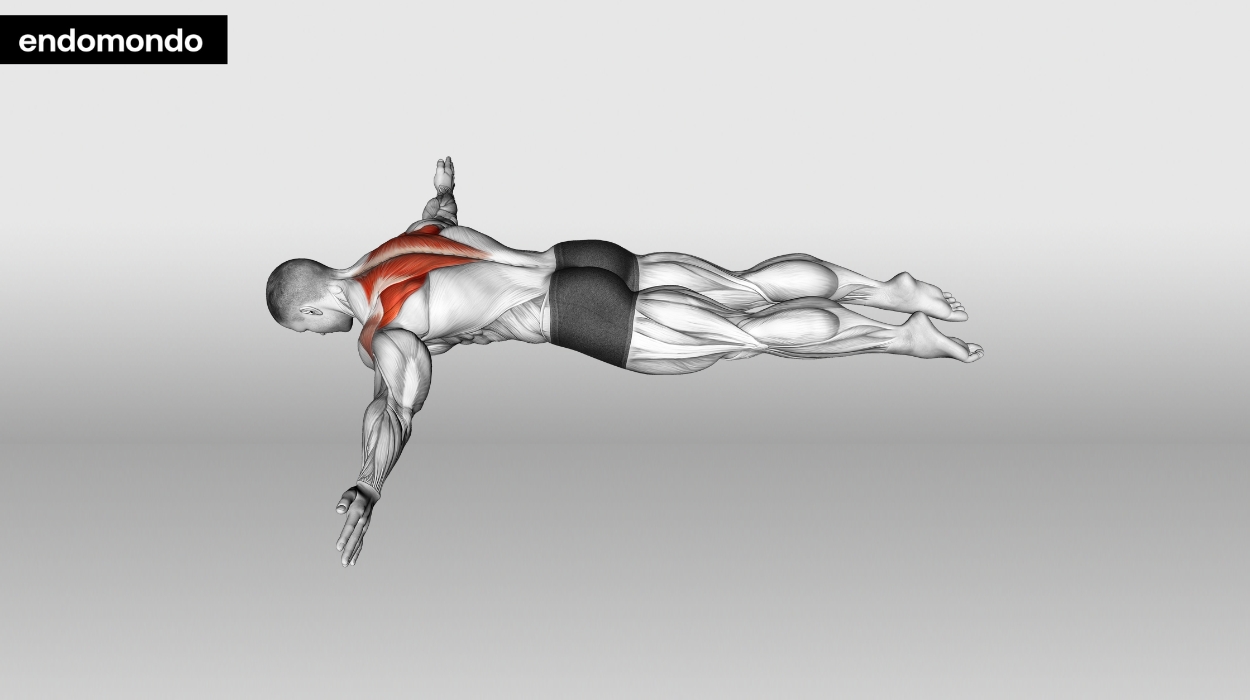
This bodyweight-only deltoid exercise effectively targets the posterior deltoids. This simple yet effective movement is a great addition to any shoulder workout. It contributes to overall shoulder health and aesthetics, creating a sculpted and balanced physique.
How to do:
- Start by lying face down on a flat surface.
- Extend your arms straight out to the side, forming a “T” shape with your body. Palms facing forward with your thumb up toward the ceiling.
- Keep your neck in a neutral position. Breathe in before beginning the exercise.
- On the exhale, lift both arms off the ground, aiming for shoulder height.
- At the top of the motion, squeeze the muscles at the back of your shoulders together.
- Hold for a count and slowly lower your arms in a controlled manner.
- Rest for a second and repeat the exercise for the desired number of repetitions.
Tips:
- Take a deep breath before lifting your arms. Exhale as you lift your arms off the ground.
- You can rest your forehead on the floor or use a towel roll at your forehead for extra comfort.
- Be sure to maintain a slight bend in your elbows.
Optimal Sets And Reps: Find a comfortable range for you. Beginners might find that 3 sets of 6-8 repetitions are a good starting point. A rep range of 12-15 could be more suitable for intermediate to advanced lifters.
Prone Y Raises
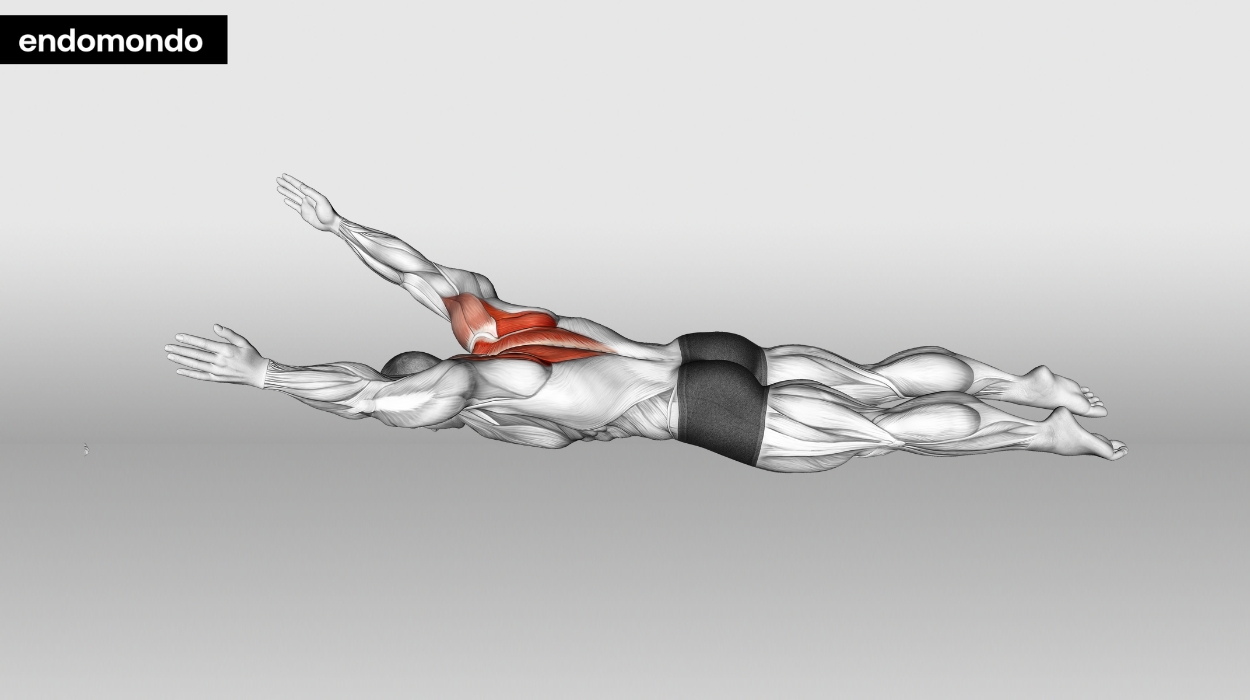
This exercise is a variation of the prone T raises in which your arms angle out diagonally to make the letter ‘Y.’ Another comprehensive movement that engages the entire shoulder complex and challenges scapular control.
Similar to other posterior delts exercises, this movement contributes to overall shoulder health by increasing shoulder mobility, reducing muscular imbalances, and increasing postural endurance.
How to do:
- Lie face down on a flat surface.
- Extend your arms straight in front of you so your elbows are near your ears.
- Lift both arms diagonally to form a “Y” shape. keeping a slight bend in your elbows. Emphasize the contraction in your rear deltoids by squeezing your blades together.
- Hold for 1-2 seconds then lower your arms in a controlled manner.
- Relax your arms and repeat the movement.
Tips:
- Maintain a neutral neck position.
- Point your thumbs upwards during the motion.
- Exhale as you lift your arms from the ground.
Optimal Sets And Reps: Find a comfortable rep range when first starting. Three sets of 6-10 repetitions is an appropriate goal for many beginners.
Reverse Plank
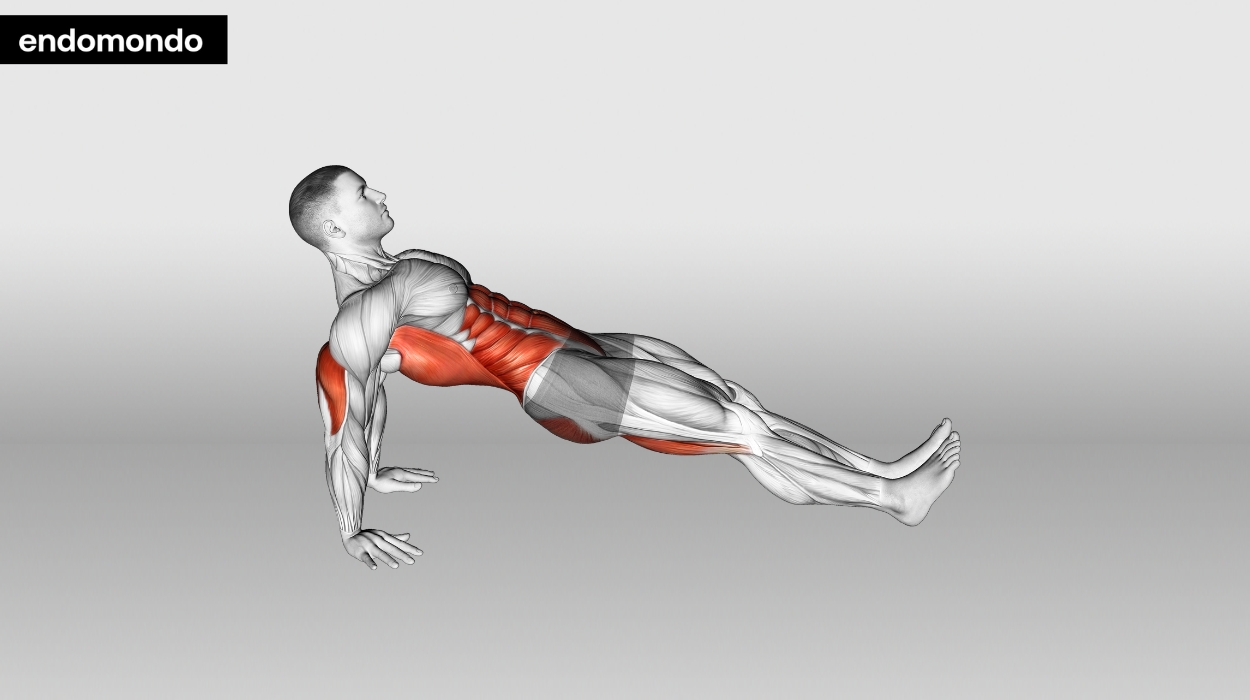
The reverse plank primarily targets the core but requires stability from the shoulder, engaging the post. delts. It also engages muscles like the glutes, hamstrings, upper back, and posterior shoulders.
This exercise involves lying on your back, lifting your hips, and forming a straight line from your shoulders to your heels. It challenges your arms to maintain extension while supporting your body weight.
This exercise is particularly benefit for individuals with limited equipment, as all you need is a solid surface.
How to do:
- Sit on the floor with your legs extended.
- Place your hands on the floor behind you, fingers pointing towards your feet.
- Press through the palms and lift your hips toward the ceiling, keeping your hands flat.
- Balance on your heels as you keep your body straight from the shoulders to the ankles.
- Maintain the straight line for the desired duration.
Tips:
- Gradually increase the duration of the hold as strength improves.
- Ensure shoulders are directly above the wrists.
- For an easier modification, keep your elbows bent and forearms on the floor instead of pushing through your palms.
Optimal Sets And Reps: Aim for 3 sets holding for 15-30 seconds to start, then gradually increase the duration by 10-15 seconds.
T Rotations
T rotations are a dynamic exercise targeting the core and shoulder muscles. Executed from a plank or pushup position, this movement involves rotating the torso to lift one arm towards the ceiling.
This exercise primarily focuses on the obliques, deltoids, and serratus anterior. The movement can also help improve rotational strength and upper spine mobility. Incorporating T rotations into your routine can also contribute to improved balance and body awareness.
It’s a great addition to any workout routine and can help with sports with repetitive trunk rotation, like golf or baseball.
How to do:
- Start in a pushup or plank position with your hands at shoulder width apart.
- Maintain a wide stance by positioning your feet outside of your palms.
- Lock your shoulders down away from your ears. Maintain a straight line in your body from your head to your heels.
- In one motion, twist your torso to the left while lifting your left arm out in front of you. Pivot your feet and rotate your hips as you squeeze your rear delts as you twist.
- Pause at the top of the movement and return to the starting position.
- Repeat on the opposite side.
Tips:
- Feel for a stretch in your chest to make sure that you are going for the full range of motion.
- To progress with this exercise, focus on pushing forcefully from the ground and gradually increase your movement speed.
Optimal Sets And Reps: Aim for 2 to 3 sets of 12-15 repetitions.
Bodyweight Back Widows
Bodyweight back widows are a bodyweight exercise that targets the upper back muscles. In this movement, you retract and squeeze the blades together as you drive your elbows to the ground.
The exercise does not require any equipment, making it very easy to include in any routine. Incorporating back widows can help counteract the effects of prolonged sitting and slouching that occurs in the upper back and shoulders.
How to do:
- Start by lying down on your back.
- Bend your elbows at roughly a 90-degree angle just outside your ribs.
- Keep your shoulders down or depressed, and drive your elbows into the ground.
- Push your chest and upper body as high as you can.
- Hold for a count.
- Slowly control your body back down to the starting position.
Tips:
- Squeeze your blades at the top of the movement.
- Take a deep breath in and press your back into the floor.
- Exhale as you raise your chest from the ground.
- Be sure not to move your neck. Keep it in a neutral position to avoid strain.
Optimal Sets And Reps: Perform 2 to 3 sets of 10 repetitions.
Rear Delt Anatomy
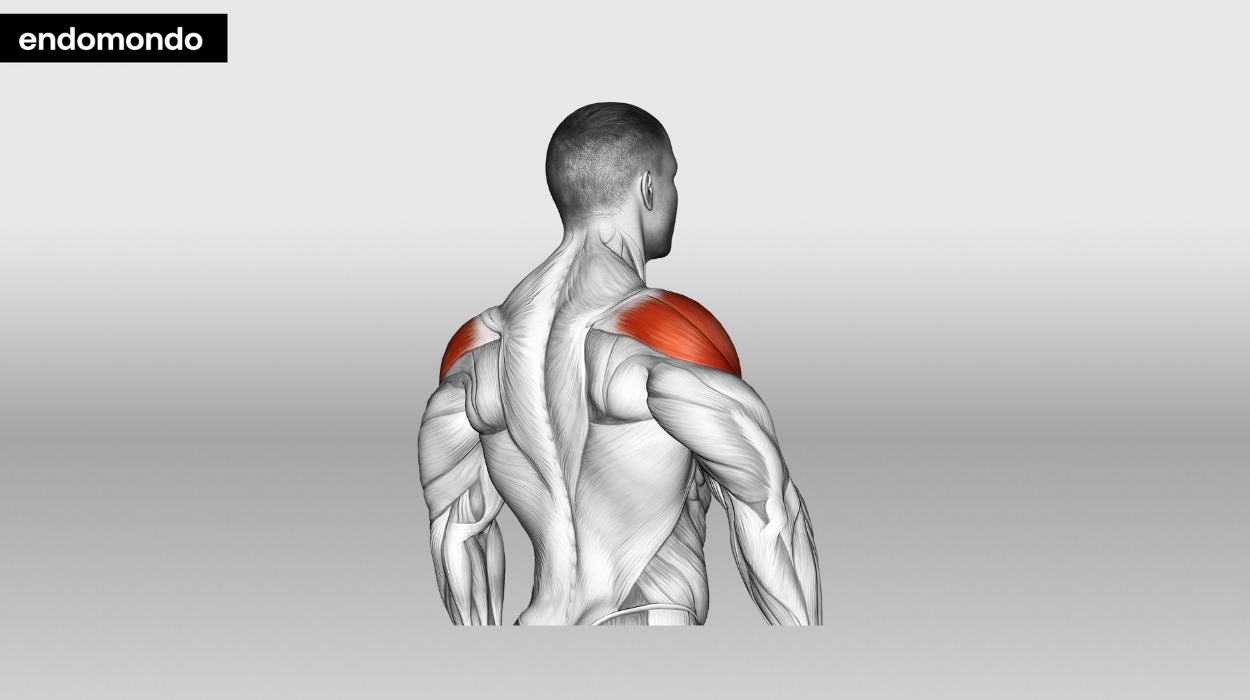
The rear delt, also known as the posterior deltoid, is one of the three muscles that make up your deltoids, the other two being the anterior and middle deltoid. The rear delt originates[2] from the spine of the scapular, or shoulder blade, and connects around to the side of your humerus or upper arm.
The rear delt works closely with muscles of the rotator cuff,[3] namely, the infraspinatus and teres major. The rotator cuff is a group of muscles that encircle the shoulder joint.
Its purpose is to provide stability and facilitate many ADLs or activities of daily living. Examples of this are carrying shopping bags, reaching overhead, getting dressed, and many throwing and lifting activities.
Function Of The Posterior Deltoid
The primary function[2] of the rear deltoid is shoulder extension, which involves moving your shoulder backward, away from the body. Every time you perform a rowing motion or pull a door open, your rear delts are at work.
Additionally, the rear deltoids contribute significantly to shoulder external rotation, which is when you turn your arm outward. This motion occurs when you reach behind your head, comb your hair, or throw a ball.
Reasons For Doing Bodyweight Rear Delt Exercises
While the anterior deltoids often receive more attention in routines, neglecting the rear deltoid muscle can lead to muscular imbalances. Incorporating specific exercises that target the rear delts is important for maintaining shoulder joint health. It helps in preventing injuries and achieving a well-balanced and proportioned physique.
Performing bodyweight exercises can be an efficient way to save time, and you can even alternate them with more traditional shoulders and biceps workouts.
Balanced Development
Achieving a well-proportioned physique goes beyond the visible muscles of the shoulder, such as the upper traps and anterior deltoids. Having a balanced development helps achieve a look of overall symmetry.
By incorporating a rear delt bodyweight workout into your training routine, you enhance the definition of the posterior shoulder. You also contribute to the three-dimensional sculpting of the entire deltoid region.
The shoulder complex is composed of several muscles that work together to allow for a wide range of motions; these include lifting, pushing, and pulling.
A well-balanced shoulder complex refers to the proper balance between these muscles and joints. This balance is essential for preventing injuries and performing daily activities with ease.
When the shoulder complex is imbalanced,[4] certain muscles may become too weak or too tight, leading to compensations and overuse of other muscles. This can result in pain, limited range of motion, and decreased functional ability.
Improved Shoulder Stability
Research highlights the importance of rear deltoid activation in promoting shoulder stability[5] and a more balanced shoulder complex. Individuals who experience anterior instability tend to have a smaller muscle area in their posterior rotator cuff. Shoulder instability is characterized by excessive forward movement of the arm in the shoulder socket.
This imbalance can lead to an increased risk of injuries such as rotator cuff tears and shoulder dislocations. Maintaining a stable shoulder complex is crucial in reducing the risk of injuries associated with joint instability.
Functional Strength
Having a well-balanced shoulder complex is not only visually appealing. It also fosters the functional strength and resilience required for daily activities.
Calisthenics can be as effective as traditional bench presses[6] for shoulder strengthening. Including targeted body weight exercises ensures a comprehensive approach to shoulder development and healthy shoulders.
Varied Training Stimulus
Introducing bodyweight workouts into your training routine can offer a range of benefits. Firstly, it can help you add variety to your workout. This can help ensure that you remain motivated and engaged over the long term.
When you perform the same exercises repeatedly, your body becomes accustomed to them, leading to plateaus in your progress. By introducing new movement patterns that challenge your muscles in different ways, you can break through these plateaus; this allows for continued gains in your strength and fitness.
Additionally, changing up your routine can have psychological benefits as well. Doing the same exercises repeatedly can become monotonous and boring. Changing the type of workout can keep your workouts from growing stale and add some excitement to your routine.
Conclusion
Adding rear delt exercises to your workout routine is important for the posterior deltoids. Examples of these include reverse fly, face pulls, and rear delt raises. Strengthening the muscles not only improves your shoulder aesthetics but also contributes to overall shoulder function and resiliency.
The rear deltoids and the rotator cuff play a crucial role in supporting shoulder mobility and function. Despite their importance, the deltoids are often overlooked and underappreciated. Calisthenics offers great versatility and can be a useful tool for anyone interested in building muscle mass and strength in the shoulders.
Frequently Asked Questions
Building the rear delts with bodyweight workouts can be effectively achieved by incorporating target movements that engage these muscles. Examples include prone T raises, ring face pulls, or the reverse plank.
Yes, you can effectively work your rear delts with calisthenics. Your own body weight can be a great alternative to typical resistance bands or dumbbells, where you can still target and strengthen the entire shoulder complex.
Neglecting any part of the body may lead to muscle imbalances, which could contribute to pain over time. It’s generally advisable to train all major muscle groups for a well-rounded and balanced physique.
As with any muscle, progressive overload is key for growth. It’s not so much that the rear delts are hard to grow than inadequate training volume and resistance to contribute to development.
Resources
- Krzysztofik, M., Wilk, M., Grzegorz Wojdała and Artur Gołaś (2019). Maximizing Muscle Hypertrophy: A Systematic Review of Advanced Resistance Training Techniques and Methods. International Journal of Environmental Research and Public Health, [online] 16(24), pp.4897–4897. doi:https://doi.org/10.3390/ijerph16244897.
- Adel Elzanie and Varacallo, M. (2024). Anatomy, Shoulder and Upper Limb, Deltoid Muscle. [online] Nih.gov. Available at: https://www.ncbi.nlm.nih.gov/books/NBK537056.
- Maruvada S;Madrazo-Ibarra A;Varacallo M (2023). Anatomy, Rotator Cuff. [online] Available at: https://pubmed.ncbi.nlm.nih.gov/28722874/.
- Joffrey Drigny, Gauthier, A., Reboursière, E., Henri Guermont, Gremeaux, V. and Edouard, P. (2020). Shoulder Muscle Imbalance as a Risk for Shoulder Injury in Elite Adolescent Swimmers: A Prospective Study. Journal of Human Kinetics, [online] 75(1), pp.103–113. doi:https://doi.org/10.2478/hukin-2020-0041.
- Ishikawa, H., Smith, K.M., J. Cade Wheelwright, Christensen, G.V., Henninger, H.B., Tashjian, R.Z. and Chalmers, P.N. (2023). Rotator cuff muscle imbalance associates with shoulder instability direction. Journal of Shoulder and Elbow Surgery, [online] 32(1), pp.33–40. doi:https://doi.org/10.1016/j.jse.2022.06.022.
- Kotarsky, C.J., Christensen, B.K., Miller, J.S. and Hackney, K.J. (2018). Effect of Progressive Calisthenic Push-up Training on Muscle Strength and Thickness. The Journal of Strength and Conditioning Research, [online] 32(3), pp.651–659. doi:https://doi.org/10.1519/jsc.0000000000002345.




